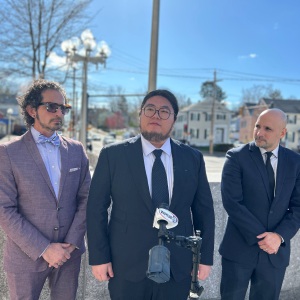Vermont hospitals implement new rules for accessing free medical care
| Published: 07-03-2024 3:10 PM |
More Vermonters should have access to free or discounted health care at hospitals and other large health care facilities under a law that went into effect Monday.
Because they are nonprofit entities, Vermont’s hospitals have long been required by federal regulations to provide some level of free or discounted health care, also known as charity care, to patients.
But in the past, different Vermont hospitals have used different criteria — such as employing different income thresholds and different residency requirements — to determine who is eligible for free or discounted medical care.
In 2022, lawmakers passed Act 119, which sets out minimum requirements for hospitals offering charity care. The ultimate goal is to help more Vermonters access free medical care, Mike Fisher, Vermont’s chief health care advocate, said in an interview.
“It creates a statewide minimum standard,” Fisher, who worked with Vermont hospitals to draft the bill, said in an interview. “Before this, we saw hospitals doing all kinds of things that didn’t make sense about how they were determining eligibility. But hospitals can be more generous than the law calls for.”
The new regulations apply to hospitals, clinics or facilities affiliated with hospitals, as well as ambulatory surgical centers in Vermont.
Under the new requirements, Vermont residents with incomes of up to 250% of the federal poverty level — which works out to $78,000 a year for a family of four — will have access to completely free medical care at Vermont hospitals. (People with health insurance who meet those income requirements will face no out-of-pocket costs for their care.)
Vermonters with incomes of up to 400% of the federal poverty level — up $124,800 a year for a family of four — will receive a discount of at least 40% on their hospital bills, or their out-of-pocket costs if they are insured.
Article continues after...
Yesterday's Most Read Articles
 Hundreds of alumni sign letter urging Beilock, Dartmouth to make a stand for academic freedom
Hundreds of alumni sign letter urging Beilock, Dartmouth to make a stand for academic freedom
 Kenyon: A year later, effects of mass arrests at Dartmouth linger
Kenyon: A year later, effects of mass arrests at Dartmouth linger
 ‘A bit Kafkaesque’: Federal judge spars with government lawyer over status of Dartmouth international student
‘A bit Kafkaesque’: Federal judge spars with government lawyer over status of Dartmouth international student
 Woodstock demotes police chief to patrol officer
Woodstock demotes police chief to patrol officer
 High school baseball: Windsor rebuilds while Thetford shines
High school baseball: Windsor rebuilds while Thetford shines
 Outgoing Alice Peck Day CEO led hospital through growth and change
Outgoing Alice Peck Day CEO led hospital through growth and change
And patients with incomes of up to 600% of the federal poverty level — up to $187,200 for a family of four — can be charged no more than 20% of their household income in medical bills.
This spring, Fisher told lawmakers in the Vermont House Committee on Health Care that five of Vermont’s hospitals were already meeting the law’s free care requirements, and seven were already meeting or exceeding the discounted care requirements.
Hospitals must now provide clear information about how to apply for discounted or free care.
A hospital’s application forms and policies must be available on its website and in its reception and billing areas, and paper copies of a hospital’s policy must be provided to patients. Hospital bills must also include a “conspicuous written notice” about the free and discounted care policies.
The law requires hospitals to allow patients to appeal rejections of their applications, and it bars hospitals from selling medical debt, something Vermont hospitals say they already do not do.
“Hopefully the policies are more accessible for folks,” Devon Green, a spokesperson for the Vermont Association of Hospitals and Health Systems, said in an interview. “Because hospitals do want to help patients get the care that they need. We don’t want patients to avoid care because they’re worried about financial issues.”
The law establishes only a minimum floor for charity care costs, and Green said that most of the state’s hospitals were already meeting those requirements or had even more generous care policies.
Fisher, the health care advocate, has argued that the new requirements will not raise costs for hospitals.
That’s because patients who fall into those income categories likely already struggle to pay their medical bills, and hospitals generally already write off the cost of that care as “bad debt.”
For hospitals, because they do not expect to receive that payment anyway, it’s a distinction without a difference, Fisher said. But for patients, freeing them from medical debt — and the potential pursuit of collection agencies — could be life-changing.
“From the hospital’s perspective, money that they don’t get is money that they don’t get,” Fisher said. “Whether it’s free care or bad debt, it goes to the bottom line as forgone revenue. But from the patient’s perspective, it’s a world of difference.”
Green, of the hospital association, said that hospitals are “largely in agreement” about that but will keep an eye on the impact of the new requirements.
If the new regulations do affect hospitals’ bottom lines, it could lead to higher prices for hospital procedures — and then higher commercial insurance premiums.
“I have been asking our hospitals to try to keep track of this and see if it will create costs,” Green said. “Because we don’t want to see a shifting of this burden onto commercial (insurance) premium payers.”






 Tree-clearing work near power lines causes Upper Valley outage
Tree-clearing work near power lines causes Upper Valley outage Lebanon to close street, block parking to allow outdoor dining
Lebanon to close street, block parking to allow outdoor dining More research time or information overload? Lawmakers weigh moving state primary elections 3 months earlier
More research time or information overload? Lawmakers weigh moving state primary elections 3 months earlier
